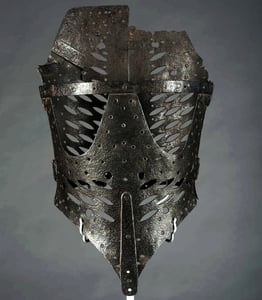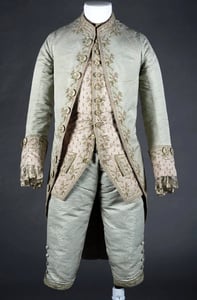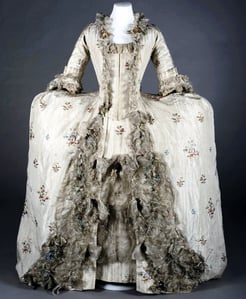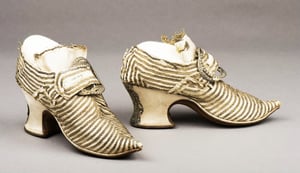The eighteenth-century styles man’s suit elaborately embroidered and jeweled formal clothing into the simpler clothing of the Regency period (1811–20), which gradually evolved to the stark formality of the Victorian era (1837-1901).
Men’s Wedding Suit. Coat for three piece suit of green corded silk with vent and fan pleats at the back. Edges, buttons and pockets embroidered in pink and green, and cuffs of pink corded silk, also embroidered finished with lace flounce. Breeches part of a three piece suit of green cord and embroidered knee bands in the style of the coat and waist coat. It has a fold opening with buttons on front and strap at the back to reduce the waist. Waistcoat part of three piece suit of pink silk to match cuffs from coat and embroidered flower pattern. Two pockets and ties to bring in the back.
This exhibition focuses on a magnificent eighteenth-century man’s suit, worn for a wedding, revealing details that tell a story about the fashions of the day and the men who wore them.
Colours and materials
In the mid eighteenth century pastel colours were very fashionable for the aristocracy. Easy to get dirty and difficult to clean, they needed a lot of attention from servants. Men and women alike wore pale shades to show their wealth and status.
The suit is made of silk and linen.
The original lace still hangs at the cuffs.
Craftsmanship
A suit like this represents thousands of hours of work, from spinning the threads to weaving the cloth, to the embroidery and lace.
Measurements
The waist is 89cm (35 inches) and the chest is 94.5cm (37 ¼ inches).
Details
Large pocket flaps were very popular, but there were not always pockets underneath.
S-shape
Men’s clothing uses stiff reinforcement in waistcoats and jackets to give a fashionable body shape. Although they look less restrictive than women’s clothes, men’s suits encouraged similar stiff, formal poses and graceful movement.
Movements
The coat is lined with pink silk, which would have showed as the wearer walked.
Styling
Jackets were worn open at the front to show expensive embroidered waistcoats.
Curve-shape
Sleeves are cut with a curve to allow the arm to bend without needing the sleeve to be too wide.
Breeches
Breeches were buttoned just below the knee, showing off knitted silk stockings.
Breech liners and shirts
Under their breeches, men wore breech liners, the linen forerunners of men’s underpants. Breech liners and shirts were changed daily and washed, while outerwear was spot cleaned and aired.
Coat tail
Coat tails were divided at the back for horse riding.
Object from York Castle Museums Costume & Textile Collection





